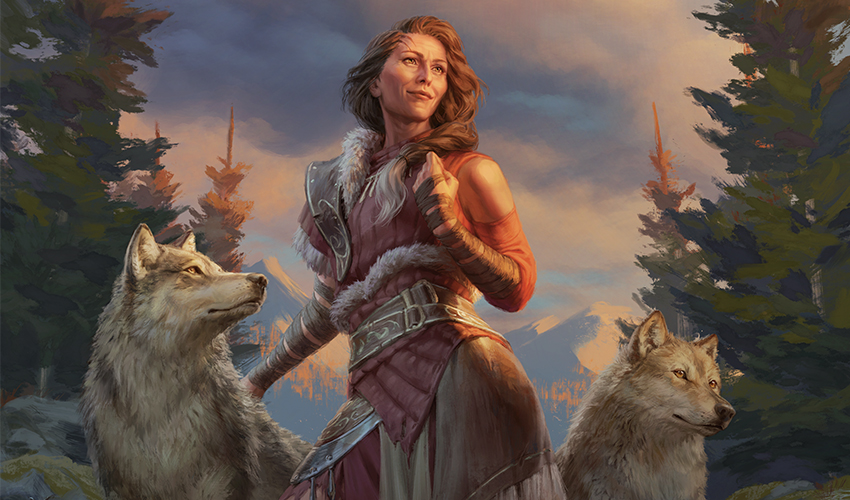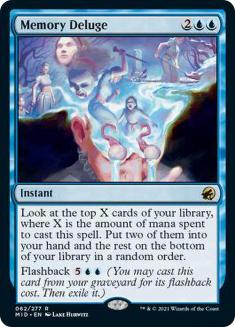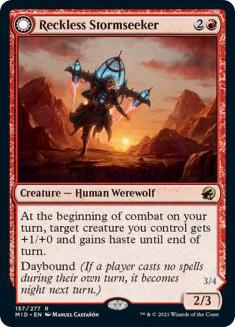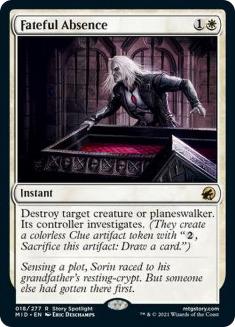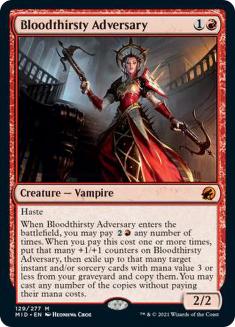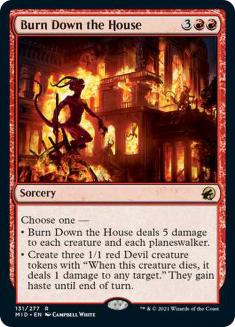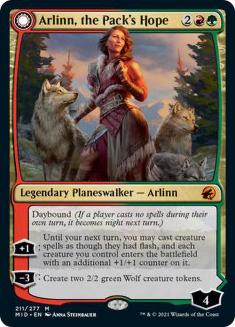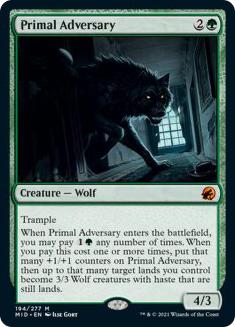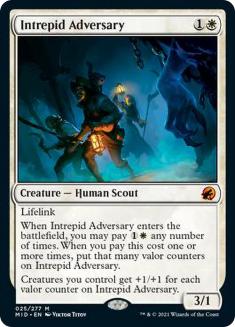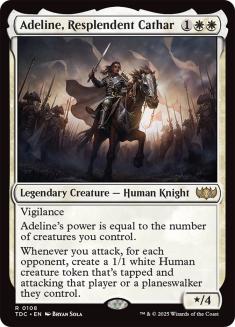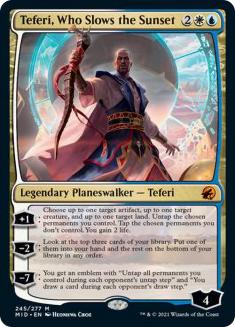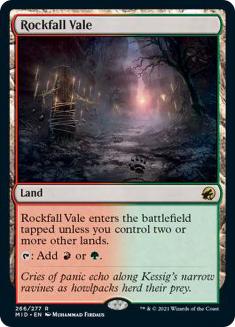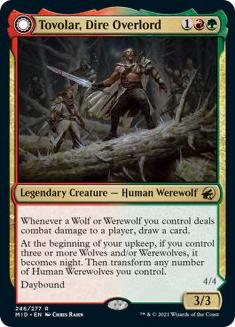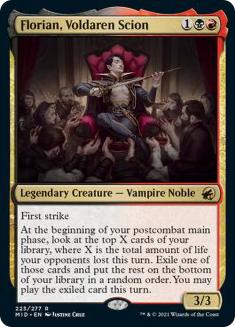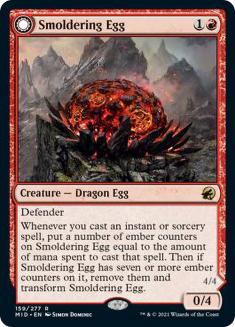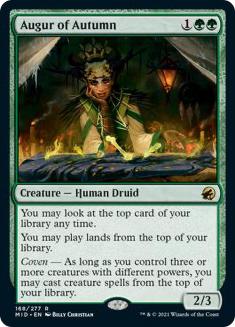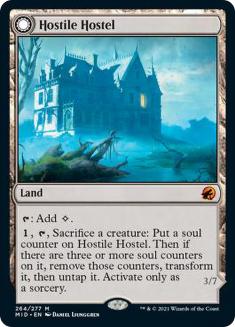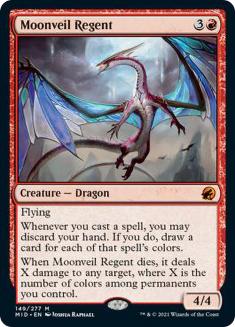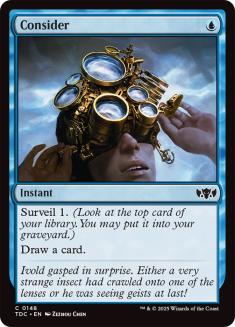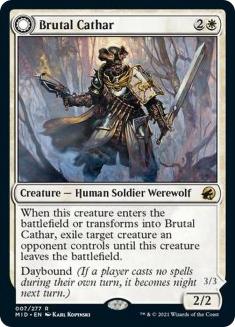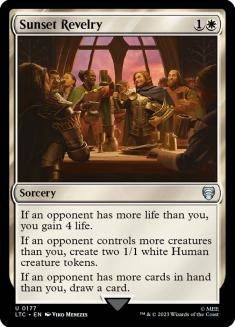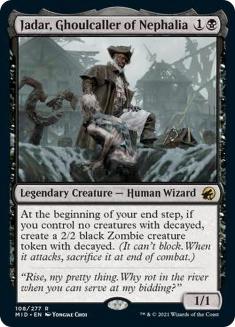Welcome to Innistrad: Midnight Hunt First Impressions week!
All week long, various members of the SCG Staff will share their thoughts on the Top 5 Innistrad: Midnight Hunt cards in each format. Today we’ll begin with Standard, Tuesday will be Historic, Wednesday will be Pioneer, and Thursday will be Modern. To add a little fun to the mix, a scoring system has been put in place so that we can get an idea of what card ranked in what place in the aggregate to close out each article. The scoring system is as follows:
- 1st — 5 points
- 2nd — 4 points
- 3rd — 3 points
- 4th — 2 points
- 5th — 1 point
Let’s start our venture into Magic’s newest set with the reigning Magic: The Gathering World Champion!
Paulo Vitor Damo da Rosa
- Memory Deluge
- Reckless Stormseeker
- Fateful Absence
- Bloodthirsty Adversary
- Burn Down the House
Picking a Top 5 for Innistrad: Midnight Hunt was a breath of fresh air, because there are just so many cards that could be on the list, but nothing that should obviously be on the list. When I did Top 5s for the last two or three sets, I struggled to find five playables; now, I have over fifteen potential playables to choose from, and they honestly could all end up being some of the most important cards in Standard since we don’t have a real metagame yet (so it’s not just about slotting cards into existing decks like it was with the previous ones). As such, my degree of confidence is very low, but my degree of excitement is very high, and I’m looking forward to seeing what my coworkers consider to be the Top 5 in the set — I expect everyone will have vastly different picks.
My pick for best card in the set for Standard is Memory Deluge. I think this card is incredible, though perhaps putting it as first is some wishful thinking on my part because I happen to like the style of deck it goes in and want it to succeed. People compare it a lot to Dig Through Time, which makes sense given its text, but it’ll play out as a mix of Glimmer of Genius and Mystical Teachings. Early on it’ll set up your draws and help you find answers, and then later on the mere presence of this card in your deck will win you the game, as it’s so likely to chain one into the other if you happen to not find enough to win the game off the first flashback.
I don’t know exactly where Memory Deluge will see play (since we don’t have an established metagame, etc.), but the only way this card won’t see play is if we have absolutely no blue control decks whatsoever, which seems very unlikely. If they exist, they’ll want this.
In second place we have Reckless Stormseeker, a card I originally slept on because I did not realize it could give itself haste. As it is, it’s a 3/3 haste creature for three mana (respectful stats) that gets to give haste to your next creature, and that’s not even mentioning the other side of it. If they don’t cast a spell and you get to flip this, assuming you cast a random 3/3 creature the following turn, this card is accounting for eight damage by itself, which is pretty absurd for a three-drop and doesn’t require that much to happen. Reckless Stormseeker also happens to curve exceedingly well with one of the best cards in the format, Esika’s Chariot. I expect this three-four punch to end games in Standard very quickly for a long time.
Then, there’s Fateful Absence. With Heartless Act leaving the format and Power Word Kill being unable to kill Goldspan Dragon (as well as several other high-end threats), something must pick up the slack in the two-mana removal department. There are some other options in the set (e.g. Infernal Grasp), but I believe Fateful Absence is the strongest and most important removal spell in it.
The main thing about Fateful Absence is that it’s an effect that we rarely see (as opposed to just another black removal spell), which gives it a lot of value. Just about every iteration of this effect has been great (Swords to Plowshares, Path to Exile, Declaration in Stone), so there’s no reason to doubt Fateful Absence will be good as well. It’s better in aggro decks than control decks, since you don’t give them the time to use the clue, but being an instant should make it appealing for control decks as well.
In fourth place, we have Bloodthirsty Adversary. I wrote about the Adversary cycle last week and I believe the best of them deserves a spot in the Top 5. The flexibility on this card is just too strong for it not to be an important two-drop in Red decks.
The coolest thing about Bloodthirsty Adversary in my opinion is that we’ve only just scratched the surface of what is possible with it. Standard is the smallest it will ever be, and each new set will bring more possibilities to Bloodthirsty Adversary. As it’s a Vampire, I also expect it to get a big boost from Innistrad: Crimson Vow. Even if the card doesn’t end up being great right now, I expect it to be one of the best cards in Standard at some point in the future.
For my fifth pick, I wanted a more speculative card, and after deciding between myriad things I settled on Burn Down the House. I’m not sure what it is about this card and I have no clue where to play it, but it just strikes me as potentially very strong.
Five mana for five damage to every creature and planeswalker isn’t new — we’ve had Hour of Devastation before, and, though it did see some play as a Bring to Light target in Five-Color Niv-Mizzet decks in Pioneer, that is the extent of it as far as I remember. So, if that’s the only thing we’re considering, Burn Down the House can see play but won’t be that great.
However, Burn Down the House offers an entirely different mode on top of being a sweeper. Sweepers can be very situational cards, so having an alternative is very powerful. Playing versus a deck with no creatures? Just make three hasted Devils (which will usually deal at least six damage). If you’re at parity or close to it, a sweeper doesn’t do you much good, but this card can let you pull ahead.
This might be a complete miss, but I think it’s a noteworthy card, so I’m noting it here!
Dom Harvey
- Reckless Stormseeker
- Arlinn, the Pack’s Hope
- Primal Adversary
- Intrepid Adversary
- Adeline, Resplendent Cathar
It’s hard to lose betting against tribal decks, especially in recent Standard, where none of the Kaldheim tribes made a mark and the party mechanic was somehow even less than the sum of its parts. I think this is finally the exception; the Werewolves in this set are priced to move and my only question is whether I have enough of them on here.
The leader of the pack here is Reckless Stormseeker, a fantastic card that’s a big draw to any aggressive red deck. By itself a 3/3 Haste for 2R with some upside is a fine rate — I’ve gladly registered Arni Brokenbrow and this is a whole lot better. In Gruul Werewolves it sets up a perfect curve of Turn 2 Werewolf Pack Leader into Turn 3 Reckless Stormseeker, attacking for six and drawing a card; in any Gruul deck, Turn 3 Stormseeker into Turn 4 Esika’s Chariot is terrifying. If the mana allows, it’s the perfect companion for another card on this list in Adeline, Resplendent Cathar. This card will warp games and often be the card the opponent fears most. If it ever transforms into Storm-Charged Slasher, blocking is officially impossible.
Planeswalkers have been refreshingly absent from Standard since Zendikar Rising but Arlinn, the Pack’s Hope is here to change that. You don’t need to care about tribal interactions to love Arlinn but this will be a cornerstone of Gruul Werewolves and a main reason to play the deck. Attacking Arlinn when the opponent has open mana is a daunting prospect, and at night Arlinn, the Moon’s Fury applies pressure quickly while shrugging off removal. It may be surprising to see Reckless Stormseeker above Arlinn but Arlinn faces stiffer competition at its mana value from Esika’s Chariot and Showdown of the Skalds. Those cards have more than proven themselves and it’s a mark of Arlinn’s quality that it will likely supplant them.
Some members of the Adversary cycle were bound to show up here and Primal Adversary gets top billing. As Paulo covered in his overview of the cycle, Primal Adversary brings even more flexibility than the others as having the lands remain untapped when animated is a crucial difference; the five-mana mode implies an extra six-mana mode and so on. Each of those modes is a bargain and I expect to see Primal Adversary show up everywhere from lean, aggressive Werewolves decks to bigger green midrange decks.
Intrepid Adversary headlines another contender in what’s likely to be a creature-heavy format; the core of Mono-White Aggro remains intact and gains some excellent tools here. A 3/1 can attack freely now without worrying about Lovestruck Beast or Bonecrusher Giant and a large lifelink creature is the ideal place to put Maul of the Skyclaves or counters from Luminarch Aspirant — but that’s just the fallback option! White aggro decks these days are more than a pile of Savannah Lions reboots; they can compete at all stages of the game and Adversary at four or even six mana will be a big part of that now.
Adeline, Resplendent Cathar rounds out the list as the perfect partner in crime for Intrepid Adversary. It’s easy to get carried away imagining games where you curve out perfectly with cards like this, but the crucial difference with Adeline is that the base rate is fine and the average case where you have one other creature is still good. When you’re firing on all cylinders, Adeline is as good as you expect. The one reservation I have is that white aggro already has several appealing three-drops in Elite Spellbinder, Skyclave Apparition, and Maul of the Skyclaves. Adeline wants you to keep your curve low.
Shaheen Soorani
- Arlinn, the Pack’s Hope
- Bloodthirsty Adversary
- Teferi, Who Slows the Sunset
- Fateful Absence
- Primal Adversary
Drafting this Top 5 list for Innistrad: Midnight Hunt Standard has been more difficult than any other in the past. Most would guess that’s due to the powering down of spells that has been taking place in the last few sets, but it’s the opposite occurring. There are too many powerful spells, but nothing ban-worthy, entering the competitive scene very soon. This set on face value is a home run, with most archetypes getting a needed boost as the powerful sets ascend into the older formats.
My Top 5 list is led by villains, cards I wish did not exist. Leading the pack is a Gruul planeswalker that will torment me for the next year in all competitive Standard events I attend. Arlinn, the Pack’s Hope is an unmitigated disaster for control decks, a permanent that can run away with the game in a blink of an eye. Heroes will have to pack their control decks full of answers for these threats, changing the dynamic back to before Standard fell apart. Planeswalkers have not been great recently, due to being banned and/or the drop in printed power level. Innistrad: Midnight Hunt slams the door shut on that chapter, bringing two very good planeswalkers that will see immediate play.
The other great planeswalker is Teferi, Who Slows the Sunset, but he falls below another aggro card on my Top 5. Bloodthirsty Adversary leapfrogs Teferi as a simple two-drop creature with haste that has an ability that may be used sparingly. The reason why it’s high on my list is the floor is fantastic, giving red-based aggro fans an easy replacement for Robber of the Rich, another creature that just attacked for two repeatedly in most games.
I’m not thrilled to see the aggro world get the pick of the litter from this set, but at least we have Teferi again! Teferi, Who Slows the Sunset is strong, when not compared to his prior forms. There’s a bit more midrange application here with the first ability and the other two are dynamite as expected. It would be tragic if a Teferi was unplayable, so I’m just happy to dodge that feeling.
For white decks, I’m more excited about Fateful Absence, which is the next card in my Top 5. Having a universal kill-all spell for white often improves my beloved archetypes, while enhancing the aggro and midrange alternatives. This removal spell will be more widely used for other decks, pushing tempo and handling immediate threats, but it’s going to be a popular, net-positive card for Standard gameplay.
The last card on my list is another aggro boost, Primal Adversary. I was torn whether to have this or Sunset Revelry be my last card. In the end, logic overtook love, and I chose the card that would have a higher impact on Standard as a whole. Sunset Revelry will be in every white deck I play until the end of time; however, it will just be a sideboard card for control decks in Standard. Primal Adversary is another powerful creature with its base stats, while having an even bigger upside than Bloodthirsty Adversary. Although it will see less play than its red alternative, it will have the power to turn a game around on its own more often.
Brad Nelson
- Rockfall Vale
- Fateful Absence
- Briarbridge Tracker
- Arlinn, the Pack’s Hope
- Primal Adversary
Lands define Standard. Sure, the cards are important too, but deciding which spells to cast always revolves around the supporting land cycles. Bad dual lands lead to monocolor decks dominating, and good dual lands allow for tricolored decks to be good which usually lends itself to more enjoyable formats. Innistrad: Midnight Hunt’s cycle of slowlands is amazing and the best of the best is most likely Rockfall Vale, as I’m predicting the colors green and red will be doing a lot of work together this fall.
Number two should probably just be my number one card, as I wrote an entire article about how I believe it has the capability to ruin Standard (CEDitor’s Note: Expect to see said article tomorrow!). Fateful Absence is a great removal spell; it might not look like it is, but it will be spectacular in the right decks. I’m really looking forward to trying this alongside Showdown of the Skalds in pretty much every shell I can think of until one sticks.
Briarbridge Tracker may not be the Tireless Tracker I was hoping for, but in all honesty may end up being better in Standard this go around. What I like about this card is how similar it feels to Thraben Inspector. That little one-drop blew us all away at how impressive it was to be able to replace itself almost immediately. Now, of course, these cards are not the same either, but drawing the comparison makes me believe this card is going to truly shine in Innistrad: Midnight Hunt Standard. Oh, and it’s a perfect play after you’ve cast Esika’s Chariot, so it’s obviously going to be amazing.
I wrote about Arlinn a couple of weeks back, and while my expectations of it have tempered, I still believe it to be one of the most powerful cards in the set. That’s mostly on the back of being able to produce two tokens the moment it enters the battlefield, especially in a world where Fateful Absence exists. Now these two Wolf tokens may not be able to protect Arlinn all the time, but that’s at least a decision point you get to make. Even in the worst-case scenarios you’re still left with some game pieces to use later.
Last on my list but first in my heart is Primal Adversary. I’m actually pretty blown away by how good of a rate this card has. For three mana, you get a 4/3 trample that may synergize in a Wolf/Werewolf deck. That’s not the best thing you can be doing, but also not the worst when trying to consistently curve out in the early turn. Later on, however, this card’s going to be a wonderful mana sink in an aggressively leaning green deck, which decks like this always want. Sure, there’s an Adversary in each color that can also do this, but none as potentially devastating as Primal Adversary.
Corey Baumeister
- Arlinn, the Pack’s Hope
- Wrenn and Seven
- Tovolar, Dire Overlord
- Bloodthirsty Adversary
- Florian, Voldaren Scion
Starting off my list is Arlinn, the Pack’s Hope. This card feels so pushed to me that it feels like they really wanted to make Gruul a thing in Innistrad: Midnight Hunt Standard; now there’s a deck that can have either Turn 3 Arlinn, the Pack’s Hope or Turn 3 Esika’s Chariot. That speed mixed with that amount of power is for sure going to be a force to be reckoned with in Standard.
What would be a good follow-up to Esika’s Chariot in this hypothetical Gruul deck? Hmmmm, I think Wrenn and Seven sound nice to me! Being able to cast this powerful planeswalker and then make a Treefolk to crew the Chariot with and copy seems like an absolutely disgusting combo. We will be dealing with it in Standard for a very long time.
Gruul doesn’t sound good enough yet? Let’s add another pushed three-drop! Tovolar, Dire Overlord will go nicely with Ranger Class and Werewolf Pack Leader to get some card advantage going with an already powerful creature stat-wise. Normally the daybound and nightbound stuff gets a bit awkward in an aggressive shell, but not with Tovolar’s ability to simply transform when the creature requirement is met. The backside of this card will cause a ton of headaches for your opponents in combat!
The last two cards will go quite nicely in an aggressive Rakdos deck. Florian, Voldaren Scion is a great way to get some card advantage going when your opponent doesn’t want to block your creatures that might be easy to bring back to the battlefield (think Skyclave Shade). Those cards will be buddies for sure.
Bloodthirsty Adversary could be the sleeper card of the set and I might regret putting it so low on my list. It gives me some serious Goblin Dark-Dwellers vibes and that card dominated Standard in the past. Being able to have the option to play it early and get aggressive versus holding onto it to pair it with a removal spell will be a strong player in Standard moving forward.
Todd Anderson
- Smoldering Egg
- Augur of Autumn
- Hostile Hostel
- Moonveil Regent
- Memory Deluge
Smoldering Egg — or Thing in the Egg as I’ve been calling it — is my pick for best card in the set. I haven’t gotten to play with it yet, but I’m confident it’s good and will be a major player in a red-based spell deck that tries to transform it quickly. The back side, Ashmouth Dragon, is a formidable creature with a machine-gun ability to take care of opposing creatures or close the game outright. The 0/4 body can play defense early, much like its predecessor, and it scales perfectly with the higher-mana-value cards that tend to see play in Standard.
Augur of Autumn is very similar to Courser of Kruphix in many ways, and if you’re lucky enough to remember the Standard formats where Courser was legal, you will know just how powerful it is to consistently hit your land drops while gaining card advantage on top. The lifegain was certainly part of the appeal of Courser, but the coven ability allowing you to cast creatures from the top of your library means you’ll never run out of gas. It isn’t quite Courser of Kruphix, but it’s close enough to be high on my list of great cards.
I wrote an entire article about Hostile Hostel already, so make sure to check that out when you have a minute. I love this land, and think it’ll be the backbone of many sacrifice decks in Standard. The only downside is that you must activate it at sorcery speed, meaning you can’t sacrifice creatures that your opponent is killing. Instead, we must build our deck to be a complete engine that fuels this land and other payoff cards. The Meathook Massacre could be a great addition to decks wanting Hostile Hostel.
Moonveil Regent is a weird one, but I think this Dragon will end up functioning like Experimental Frenzy. Many people pegged Experimental Frenzy as a powerhouse engine for red decks, but Moonveil Regent hasn’t received the same. Every spell you cast makes you discard your hand and draw one or more cards, meaning you can hit a land pocket and be in a little trouble…unless you build your deck with a ton of cards with flashback!
It shouldn’t be too hard to make Moonveil Regent work. There are so many ways to cast extra spells in the new set that you should be able to continuously cycle through spells as long as you have the mana to cast them. Moonveil Regent also works really well with anything that says “draw a card” on it, specifically because the ability will resolve and draw cards before the spell does, meaning it is less likely you’ll flood out.
Lastly, I wanted to talk about Memory Deluge, a draw spell that has been compared to Fact or Fiction. It isn’t as good as Fact or Fiction. It isn’t as good as Dig Through Time. However, it is comparable to both and is certainly in the ballpark for playable in Standard. If you’re playing a reactive control deck, I imagine this will be the draw spell of choice for just about everyone. You get to sit back and cast it whenever it is convenient. It gains raw card advantage and card selection, much like Dig Through Time. You also get to pick the cards, where Fact or Fiction allows the opponent to choose.
However you play with Memory Deluge, you should end up happy. Just make sure you pair it with a bunch of removal and counterspells to keep your opponent in check while you create space for it to resolve. Draw spells like this need the rest of the deck to be interactive. This is the new Mystical Teachings. This is the new Torrential Gearhulk. This card is expensive but powerful, so build around it accordingly.
Bryan Gottlieb
- Wrenn and Seven
- Consider
- Moonveil Regent
- Memory Deluge
- Brutal Cathar
My last few Top 5 lists have not gone particularly well (still waiting on that Orcus, Prince of Undeath train to come in) so it was time to play things a little closer to the vest. No contrarian larks. No looking for the cards with deeply hidden potential. Just good solid Magic cards.
We can start off that trend with Brutal Cathar, a Fiend Hunter variant that honestly shocks me with how good it is. Even taking away the back side, Brutal Cathar is easy to splash, the body is larger than these things usually are, and the creature type is fantastic. However, there’s a back side, and that Werewolf has a ferocious bite as well as a long shot chance at gobbling up multiple creatures.
Memory Deluge feels like the type of tool control used to get. Survive for a bit, and Memory Deluge will be your late-game engine while also getting you out of any tight spots where only a specific answer will do. I’ve also appreciated its combo applications, and I could see myself using Memory Deluge to chain some Alrund’s Epiphany together in the near future.
I thought Moonveil Regent had potential to be my number one card in the set, but I’ve sort of hit a wall for places to leverage its powerful ability. Make no mistake though, where this card shines it will be among the best cards in Standard. Mono-Red Aggro treats this like an Experimental Frenzy with upside, and I love how it looks in more tempo-based builds of Delver that are burning cards for effects like Fading Hope.
All right, here’s the boring part of my list. Consider is the best cantrip we’ve had in a long time. In some Standard formats, the upgrade from Opt would be marginal. In this Standard format, loaded with powerful flashback spells, I think Consider is a game-changer. Accompanying powerful graveyard synergies are creatures like Delver of Secrets, Moonveil Regent, Poppet Stitcher, Sedgemoor Witch… all set up to benefit from Consider’s existence.
Finally, we come to Wrenn and Seven. Standard has not been planeswalker focused for a while now, and I sure hope you enjoyed the break, because Wrenn and Seven is on another level. It’s kind of good in every green deck, much the same way Nissa, Who Shakes the World was. It doesn’t hurt that green’s best card right now, Esika’s Chariot, is a perfect curve companion to Wrenn and Seven. Add in the ability to fuel graveyards, generate mana and card advantage, serve up plenty of loyalty to flashback Light up the Night, and so, so many other applications and you might not just be looking at the best card in Innistrad: Midnight Hunt — this might be the best card in Standard.
Ari Lax
- Wrenn and Seven
- Sunset Revelry
- Jadar, Ghoulcaller of Nephalia
- Moonveil Regent
- Arlinn, the Pack’s Hope
You could probably shuffle these five cards and convince me the ranking was right, but it’s worth discussing each of them.
Wrenn and Seven is just a lot. The token is just a perfect size with abilities, and Wrenn’s other numbers are also great. Definitely a worthy five-drop planeswalker.
If you didn’t play Standard aggro decks against Timely Reinforcements, it was oppressive. I expect Sunset Revelry to be similarly gross to play against, and it’s the single card in the set that stands out the most as a potential mistake.
Jadar, Ghoulcaller of Nephalia does a lot of good stuff. It has a bunch of good types between the actual Human Wizard and the Zombie token, and that’s beyond the basic value of making bodies forever. It’s just a cog though, with a lot of people working on it.
I’m not as high on Moonveil Regent as Bryan Gottlieb might be, but I also know the power of Mindmoil and I’m not underestimating the card. Remember, it’s optional to discard your hand, and if you just draw two good cards you get to cast them.
Arlinn, the Pack’s Hope is another planeswalker that is “a lot” just on the metric of making two significant tokens, but it directly competes with Esika’s Chariot and doesn’t have the heads-up against Goldspan Dragon on lock, so it drops down the rankings relative to Wrenn.
Cedric Phillips
- Wrenn and Seven
- Arlinn, the Pack’s Hope
- Burn Down the House
- Memory Deluge
- Fateful Absence
Wrenn and Seven is the kind of planeswalker that’s geared towards exactly Standard-level play. It has three fairly strong normal abilities and an ultimate that everyone can mostly ignore, and is meant to be cast with five (or more) lands on the battlefield. In older formats like Pioneer or Modern, you’d be accelerating to this card via Llanowar Elves and similar mana creatures, but that’s actually a fairly weak thing to do because you’re likely not in search of more lands via its [+1] (I imagine you want more real cards, not lands), you don’t have any interest in putting more lands on the battlefield because you’re likely skimping on them for mana creatures in the first place, and if you’re accelerating to Wrenn and Seven via mana creatures, its [-3] is making a… 3/3 Treefolk I guess?
Standard promotes playing your lands and your spells so the initial Treefolk in that format will almost certainly be a 4/4 at worst (though I expect it to be a 5/5 a high percentage of the time) and finding more lands is ideal to either cast your more expensive spells or to be able to double-spell more easily since the average mana value of Standard green decks is much higher than in older formats. There’s a lot to like here and I’d be shocked if it isn’t hugely impactful.
Arlinn, the Pack’s Hope is about as obvious as it comes as a powerful two-color planeswalker, but since Gruul is so well situated as a color combination right now, it gets an extra bump up my list. As many have noted, control decks are going to struggle against this thing, but it’s also solid in Gruul mirrors since it creates two tokens to either battle Esika’s Chariot’s Cat tokens or to trade with The Catillac itself. Toss in the fact that two 2/2s likely roadblock linear aggro decks as well and, just like with Wrenn and Seven, I’d be shocked if this one isn’t hugely impactful as well.
PVDDR is taking a flyer on Burn Down the House in his Top 5 list but I actually think it’ll be an integral part of control decks existing post-rotation. If one believes that Wrenn and Seven and Arlinn, the Pack’s Hope are going to be intensely impactful cards in Innistrad: Midnight Hunt Standard — and the above paragraphs tell you that I very much do — there has to be a way to beat them (besides The Banhammer™ of course!). I believe the combination of Burn Down the House and Burning Hands is the best place to start at combating this upcoming dynamic duo. Izzet Control went from rogue to legit very quickly at the back end of the last Standard format, and while that deck is losing a sizeable amount of tools, I believe these fire-based tools can help in the war against these powerful planeswalkers.
Plus, whenever you cast it, you can sing “Burn The House Down” by AJR. Which, if you ask me, is more than enough reason to play the card.
Speaking of new additions for Izzet Control, Memory Deluge is the card drawing spell the deck needs to tie the room together. Dig Through Time and Fact or Fiction this is not (nice lazy comps Magic hivemind!), but it’s still plenty playable and if you ever get to flash it back, losing strikes me as incredibly difficult. Honestly, there’s not much more to say about the card past this. It’s obviously powerful and if a control deck exists, this will be a huge reason as to why.
Lastly is a solid removal spell in Fateful Absence. Much like Memory Deluge, there isn’t a ton to say here. Control decks needs to manage creatures and planeswalkers, and even if the cost is a Clue token, when the alternative is dying and shuffling up for Game 2, a Clue token sounds like a nice compromise. Declaration in Stone is the lazy comp but that card was better served in aggro strategies than Fateful Absence given its proactive nature. Fateful Absence being more reactive is a nice feather in its cap for Shaheen Soorani and his brethren of control mages.
Making a Top 10 list would have been easy this time around, but since five is all that’s required, I’m pretty happy with my selections even if I think there are about fifteen cards that could be awesome in this set for Standard. It seems as though the FIRE days of Magic are temporarily over. Thank goodness…
And now, without further ado, the SCG Staff’s Top 5 Innistrad: Midnight Hunt cards for Standard are…
5. Bloodthirst Adversary — 8 points
4. Reckless Stormseeker — 9 points
T-3. Memory Deluge and Fateful Absence — 10 points
2. Wrenn and Seven — 19 points
1. Arlinn, the Pack’s Hope — 21 points
Cya back here tomorrow for our thoughts on Innistrad: Midnight Hunt’s impact on Historic!

